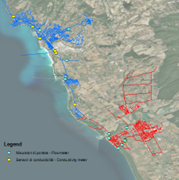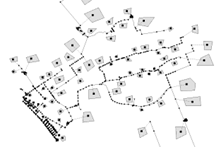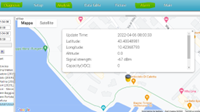
Description of the technology
Most of the coastal aquifers in Mediterranean countries, such as Italy, Spain, Croatia, Greece, Albania, Turkey and Morocco are karstic and at risk of overexploitation and seawater intrusion (SWI) (Telahigue, Mejri, et al., 2020). SWI is a widespread environmental and health problem, especially in coastal aquifers where fresh groundwater resources are significantly threatened by saline water (Mastrocicco, Busico, et al., 2019; Abdoulhalik, Ahmed, et al., 2017; Singh, 2014). Wastewater treatment plants (WWTPs) are among the most important infrastructures, especially in coastal cities with a risk of flooding and they also have problems with SWI. From the wastewater treatment point of view, possible effects of high salinity influent on WWTPs include an increase in osmotic pressure in the mixed liquor sludge that leads to a reduction in microbial metabolism or an increase in viscosity that hinder oxygen diffusion. It can affect nutrient removal processes due to changes in microbial communities in saline conditions that further ends up with nutrient-rich effluents and eutrophication in surface waters (Egea-Corbacho, Romero-Pareja, et al., 2021). In addition, high salinity limits the reuse possibilities of the final water requiring highly expensive and energy intensive treatments like Reverse Osmosis. There is a need to develop appropriate management models for assessing possible solutions that cease the adverse effects of seawater intrusion on WWTPs and water reuse purposes.
The Aretusa consortium is a PPP between the water utility “ASA Azienda Servizi Ambientali Spa”, the industry “Solvay Chimica Italia spa” and the technology provider “Termomeccanica Ecologia Spa”. The consortium was founded in 2001 to build the Aretusa post-treatment plant. This plant is fed with part of the effluents produced by the urban Wastewater Treatment Plants (WWTPs) of Rosignano and Cecina, refining the quality and allowing industrial reuse in Solvay chemical plant. Cecina and Rosignano are two municipalities placed along the coast in Tuscany region (Italy) and are frequently subjected to seawater intrusion in the sewer systems. This condition can lead to an alteration of the water quality delivered to Aretusa plant and, consequently, to Solvay industrial area. To predict and reduce, as much as possible, the salinity of the final water delivered for industrial reuse, a digital monitoring system is being developed including three main tools:
- Early Warning System (EWS) to monitor in real-time the conductivity in key points of the sewer network and at the WWTPs of Cecina, Rosignano and Aretusa sending alarms when a defined threshold is exceeded.
- Smart equalization tool which allows to regulate the amount of flow delivered to Aretusa from Cecina and/or Rosignano based on the predicted conductivity of the two streams.
- Match-making tool to identify other possible uses of the refined water when the salinity of the water does not allow the industrial reuse by Solvay.
To implement the three digital tools a network of both flowmeters and conductivity meters has been installed in key points of the sewer network and at the three WWTPs. Results coming from these sensors, together with the meteorological data will feed the artificial neural network (ANN) of the Early Warning System. The EWS will send warnings when thresholds of salinity are exceeded in the key points of the sewer network which may results in exceeding the conductivity limits requested for the reuse of the water at the WWTPs.
As for the smart equalization, a model of the sewer network of both Cecina and Rosignano has been built, allowing for a forecast of the quantity and quality of the wastewater entering the two corresponding WWTPs. Results from the simulations will be integrated with the results from the sensors to identify which of the two streams will bring higher salinity. This data will be used by a specific algorithm which, based on the forecasted conductivity of the two streams, will automatically define the amount of water to be delivered in Aretusa from Cecina and Rosignano WWTPs. In practice, the algorithm will send a signal to open as much as possible the automatic valve installed in Rosignano if the conductivity of the water coming from Rosignano is lower with respect with the one coming from Cecina, in the opposite case the algorithm will switch on the pumps delivering the water from Cecina minimizing the water delivered from Rosignano.
Finally, the match-making tool will identify other possible uses of the wastewater based on the salinity of the water, in particular considering the tolerance of different crops to the conductivity of irrigation water.
Flow scheme of the technology



Synergetic effects and motivation for the implementation of the technology
- Increase water reuse and avoidance of exceeding Solvay limits for reuse
The application of the different tools will allow to minimize the salinity and maximize the water delivered to Solvay for industrial reuse. In addition, the match-making tool will also identify other possible uses of the final water (mainly agricultural reuse).
- More effective and efficient management procedures of WWTPs and sewer network
The modeling and digitalization of the network and WWTPs can be a decision supporting tool to optimize the management of the sewer networks and WWTPs allowing for faster intervention. In particular, the models of the two networks can be used to test different management and structural solutions to improve the efficiency of the system.
Technology requirements and operating conditions
The tools need to be calibrated and supported by monitoring data collected via sensors installed at the sewer network and at the WWTPs. For the modelisation of the sewer network a deep knowledge of the network is needed, including, information about pipes, manholes, pumping stations. The network needs to be divided in main section and key points have to be selected to have information about the main streams entering the network. To do this, flowmeters have to be installed in these points. Being salinity the main objective of the monitoring also conductivity meters have been installed in this specific case. A sampling campaign during both summer and winter season is necessary to get qualitative information. Finally, in case of mixed sewer network rainfall data needs to be collected from meteorological station. Sensor data needs to be collected for at least one year.
Case Study applying the technology
Publications
- Abdoulhalik, A., Ahmed, A., and Hamill, G. A., A new physical barrier system for seawater intrusion control., 2017
- Egea-Corbacho, A., Romero-Pareja, P., Aragón Cruz, C., Pavón, C., and Coello, M. D., Effect of seawater intrusion using real wastewater on an attached biomass system operating a nitrogen and phosphorus removal process, 2021
- Mastrocicco, M., Busico, G., Colombani, N., Vigliotti, M., and Ruberti, D., Modelling actual and future seawater intrusion in the variconi coastal wetland (Italy) due to climate and landscape changes, 2019
- Singh, A., Optimization modelling for seawater intrusion management, 2014
- Telahigue, F., Mejri, H., Mansouri, B., Souid, F., Agoubi, B., Chahlaoui, A., and Kharroubi, A., Assessing seawater intrusion in arid and semi-arid Mediterranean coastal aquifers using geochemical approaches, 2020

